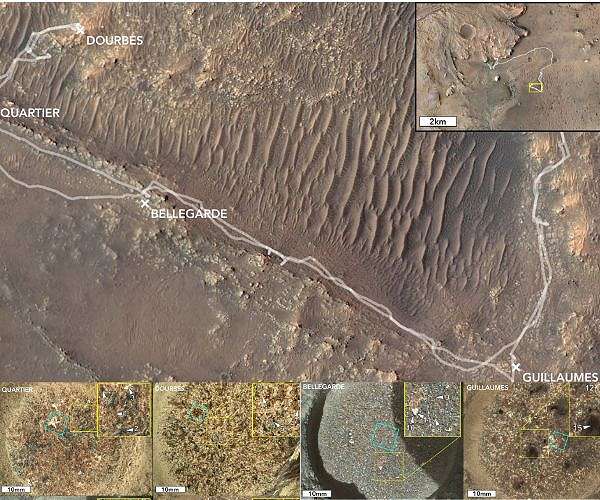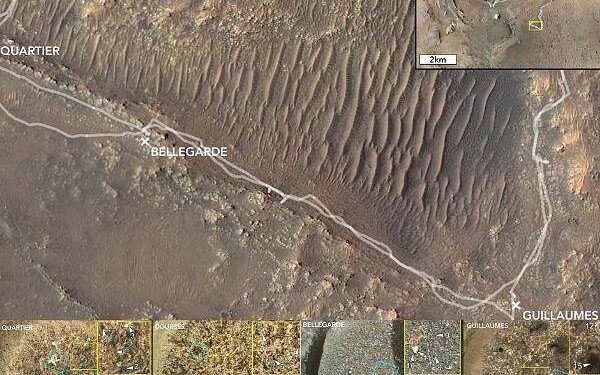
Three years later, search for life on Mars continues
by Staff Writers for UC News
Cincinnati OH (SPX) Feb 27, 2024
In the three years since NASA’s Perseverance rover touched down on Mars, the NASA science team has made the daily task of investigating the red planet seem almost mundane.
The rover and its helicopter sidekick Ingenuity have captured stunning images of Mars and collected 23 unique rock core samples along 17 miles of an ancient river delta.
One science team member, University of Cincinnati Associate Professor Andy Czaja, said he sometimes has to remind himself that the project is anything but ordinary.
“This is so cool. I’m exploring another planet,” he said.
Czaja teaches in the Department of Geosciences in UC’s College of Arts and Sciences. He is a paleobiologist and astrobiologist helping NASA look for evidence of ancient life on Mars using a rover outfitted with custom geoscience and imaging tools with three of his UC graduate students, Andrea Corpolongo, Brianna Orrill and Sam Hall.
Three years into the mission, the rover has performed like a champ, he said.
“Perseverance has excelled. It’s been fantastic. It has such capable instrumentation for doing the geology work. It’s able to explore distant objects with its zoom lens cameras and can focus on tiny objects at incredible resolution,” Czaja said.
Along the way, the mission has recorded a number of firsts: first powered flight, first recorded sounds of Mars, the longest autonomous drive (nearly a half-mile) and new discoveries about the planet’s geology, atmosphere and climate.
Czaja was part of the NASA team that decided where on Mars to land the rover. And he remained on the science team that would pore over its daily data and discoveries to decide what the rover should do next.
Among the new discoveries was finding primary igneous rocks in Jezero Crater. These rocks are the hardened result of liquid magma. They offer scientists promising clues about refining the known age of the planet.
Scientists suspect Mars once had long-lived rivers, lakes and streams. Today, water on Mars is found in ice at the poles and trapped below the Martian surface.
Czaja and his student Corpolongo were co-lead authors of a paper published in the Journal of Geophysical Research, Planets that revealed that Mars also may have had hydrothermal systems based on the hydrated magnesium sulfate the rover identified in the volcanic rocks.
“When those rocks cool off and fracture, they become a habitable environment for life,” Czaja said.
Corpolongo also led a similar research paper in the same journal co-authored by Czaja detailing the results of the rover’s analysis of samples using the SHERLOC deep ultraviolet Raman and fluorescence instrument. Both papers featured contributions from dozens of their fellow NASA researchers on the project.
Samples collected by the rover may finally answer the question about whether we are alone in the universe.
“We have not found any definitive evidence of life in these deposits yet. But if there were fossil microorganisms trapped in the rocks, they would be too small to see with the rover,” Czaja said.
Czaja is hopeful funding will be approved for the anticipated Mars Sample Return mission to retrieve the hermetically sealed titanium tubes scientists have spent three years filling with interesting rock cores.
“These hydrated minerals trap water within themselves and record the history of how and when they formed,” the study said. “Returning samples of these minerals to Earth would allow researchers to explore the history of Mars’ water and climate and possibly evidence of ancient life with the most sensitive instruments possible.”
But that was just the beginning. Perseverance began its deliberate exploration from the floor of the crater to the front of the delta, formed by an ancient river or drainage channel where it encountered sedimentary rocks that often contain trapped minerals and another avenue for evidence of ancient life.
And last year the rover made it to the crater’s margin in what used to be an enormous lake where it is exploring deposits of magnesium carbonate, which can form geologically or biologically from bacteria.
Czaja said the decision to send Perseverance to Jezero Crater appears to be paying off.
“Absolutely. There were other places we could have gone that might have been just as good,” he said. “You won’t know until you explore them all. But Jezero was picked for good reason and it has been completely justified.”
The helicopter Ingenuity’s flying days appear to be over after it sustained rotor damage in January after landing on its 72nd flight. But Perseverance is still going strong. It still has 15 sample tubes at its disposal to capture additional interesting geologic specimens.
Next the rover will make its way out of Jezero Crater to explore the wider area. Czaja said they are likely to find rocks dating back 4 billion years or more. And Mars could harbor stromatolites or rocks that contain evidence of ancient layered mats of bacteria visible to the naked eye. On Earth, these rocks are sometimes found in extreme environments such as geyser basins.
The horizon of discovery continues to expand daily before the science team.
“I hope that Perseverance has just whetted our appetite for more Martian exploration,” Czaja said. “And bringing back samples will allow us to study Mars and search for evidence of ancient life with instruments that haven’t even been invented yet for years and years to come.”
Research Report:Evidence of Sulfate-Rich Fluid Alteration in Jezero Crater Floor, Mars
Related Links
University of Cincinnati
Mars News and Information at MarsDaily.com
Lunar Dreams and more
